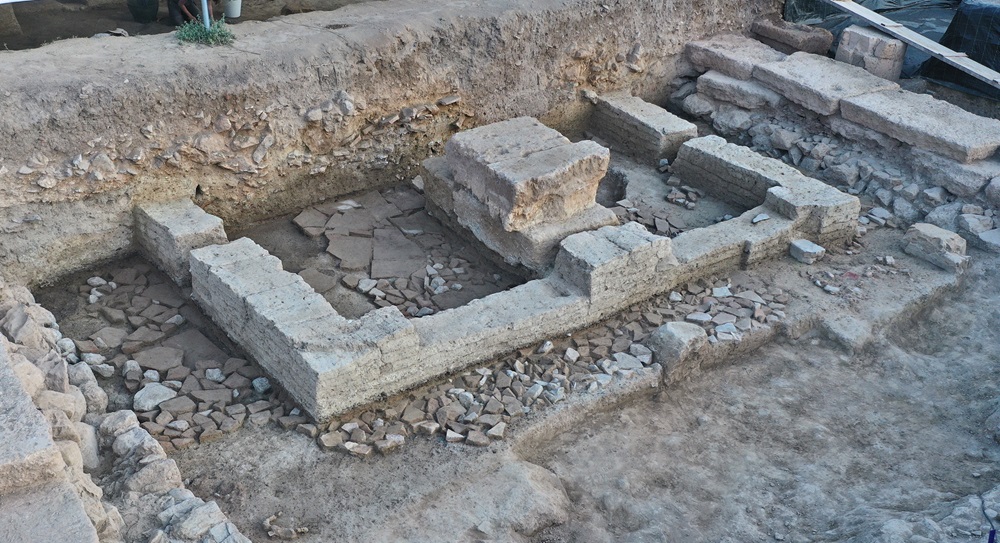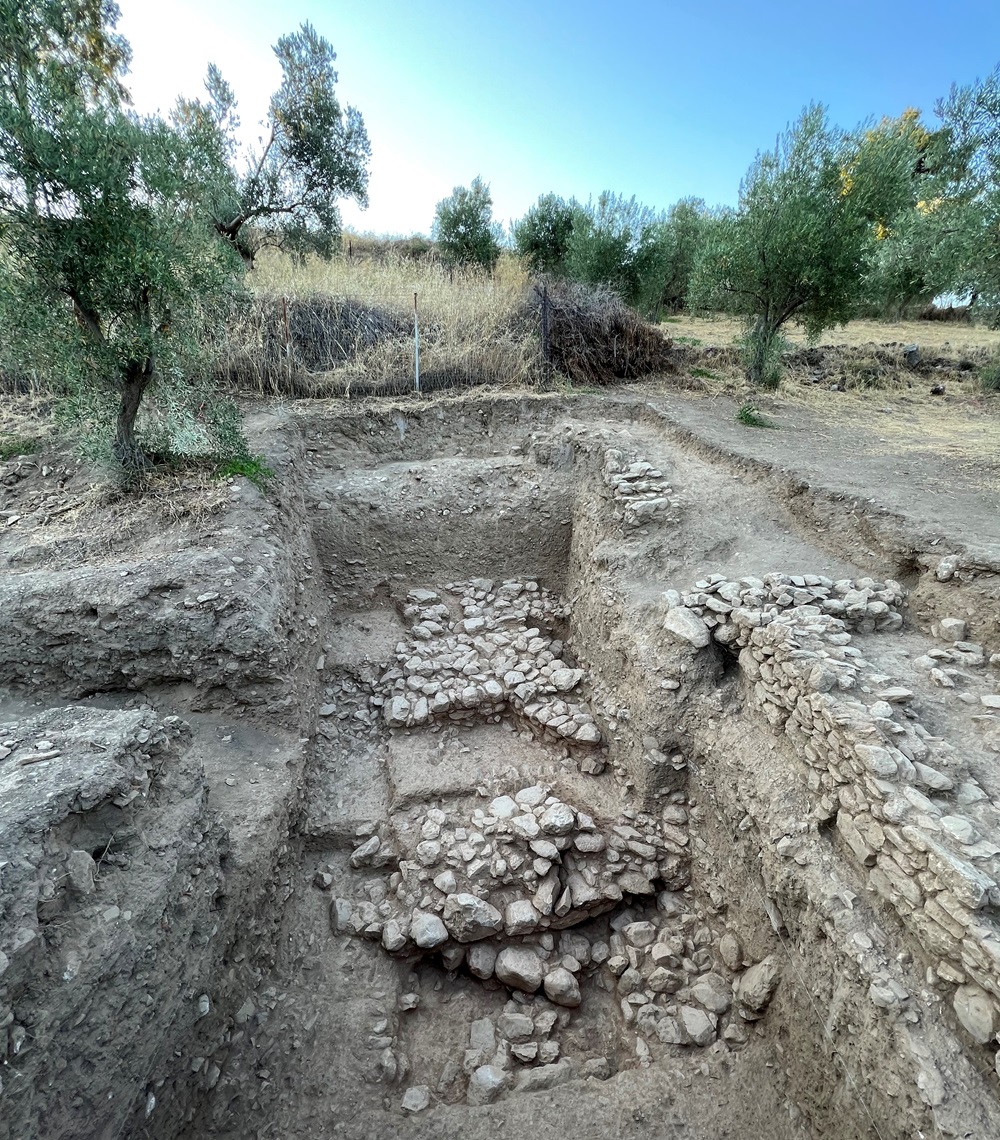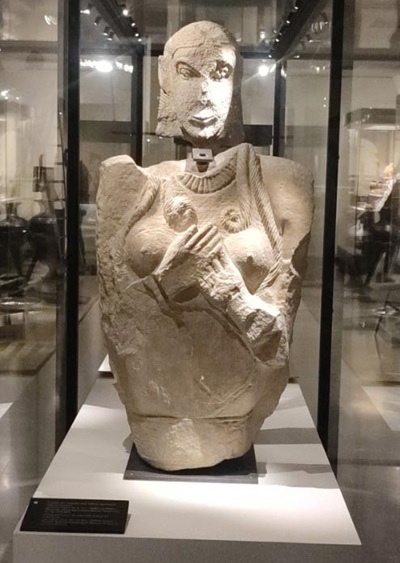
Every summer, a team of Swiss and Greek archaeologists investigate the remains of the sanctuary of Amarysia Artemis near Amarinthos in Evia. The excavation period just completed marked a new phase in this research project, which began some fifteen years ago. Under the foundations of the temple of the goddess, structures were uncovered that testify to the antiquity of her worship.
The first archaic temple
Already in 2017, archaeologists unearthed the foundations of a monumental building in the heart of the sanctuary. The excavations that followed proved that this was the temple of the goddess Artemis, built towards the end of the 6th century BC. Although the superstructure and decoration of this building, measuring approximately 39 x 11 m, have been almost completely destroyed, its foundations protected the walls of earlier buildings, the remains of which are preserved in excellent condition.
The excavations of 2023 completed the discovery of another temple dating back to the 7th century BC. Its length reaches 100 feet (or 34 m),. On its eastern side, the temple preserves a well-built wall with a pilaster, while its western side ends in an arch. The temple is built of raw bricks on solid dry-stone foundations, which proves that the soil was still swampy at the time of its construction. Along the inner wall, the temple was supported by pillars which are found at regular intervals, and which undoubtedly helped to support a heavy tiled roof.

The altars of the goddess
One of the peculiarities of this temple is the significant number of structures that were found inside it. Several hearths in altar use (?) were found in the centre of the cella. In addition, the horseshoe-shaped altar, which was originally thought to have stood outside the temple, occupies a space that can be described as a porch. A thick layer of ash, rich in charred bones, testifies to the long use of these structures. The possibility that some of them predate the temple cannot be excluded: the first level of use of the horseshoe-shaped altar yielded pottery dating to the end of the 8th century BC.
As in previous years, the excavation of the Archaic temple brought to light rich offerings: Corinthian alabastra, Attic vases, ritual prochos of local production, as well as jewellery made of precious materials (gold, silver, coral, amber), amulets from the East, bronze and iron armament components.
The temple was partially destroyed, probably by fire, in the third quarter of the 6th century BC. Subsequently, brick partitions were placed to protect the centre of the worship area until the new temple was built towards the end of the 6th century.

Before the Archaic period
Below the levels of use of the first Archaic temple, dry stone walls are found, which belong to an elongated building of the same orientation, with modifications in its interior, whose exact dimensions and plan remain to be clarified. In front of this building, the layers older than the horseshoe-shaped altar yielded several bronze figurines of the Geometric period representing bulls and a ram, while a clay bull’s head of the Mycenaean period is striking. Outside the temple site, test cuts also revealed the remains of buildings from the 9th and 8th centuries BC, testifying to the extent of the site at that time. Although research on these oldest levels has only just begun, the first discoveries suggest that the cult had its roots in the centuries after the end of the Mycenaean period.
The prehistoric settlement on the hill of Paleoekklisia
The excavation cuts on the hill of Paleoekklisia confirmed the existence of imposing walls of the Early Bronze Age (3rd millennium BC) that undoubtedly belong to a system of fortification of the prehistoric settlement, which extended on the slopes and the top of the hill. The remains of the following centuries have almost entirely disappeared due to soil erosion, with the exception of a tomb from the beginning of the Late Bronze Age, which has been excavated near the hilltop plateau and in which skeletons with their remains have been found.
Understanding the integration of the sanctuary into the ancient landscape
Alongside the excavations of the sanctuary, a systematic surface survey is being carried out in the Sarandapotamos catchment area that extends between Amarinthos and the ancient city of Eretria. This research aims at understanding the integration of the sanctuary into the ancient landscape through the study of the evolution of the environment from antiquity, the distribution of rural settlements over the centuries, the cemeteries, the quarries, the agricultural land, as well as the ancient communication network, with emphasis on the “Sacred Road” that connected Artemisium of Amarynthos with Eretria.

The excavation and research team
The excavation team gathered in 2023 more than 50 archaeologists, conservators, other specialists, workers and students from Switzerland, Greece and other countries. The Amarynthos research project is a collaboration of the Ephorate of Antiquities of Evia of the Ministry of Culture, under the direction of Angeliki G. Simossi, Head of the Ephorate of Antiquities of Piraeus and the Islands, who was Head until the end of 2022 at the Ephorate of Antiquities of Evia, and Sylvian Fachard, Director of the EASE and Professor at the University of Lausanne. The field research is directed by Olga Kyriazi (EFA Evia) and Tobias Krapf and Tamara Saggini (EASE).







Leave A Comment